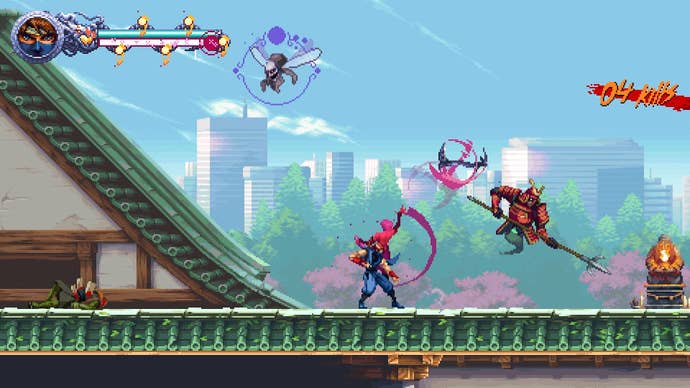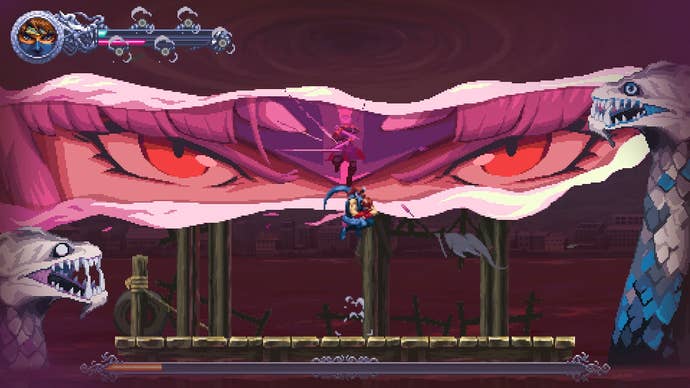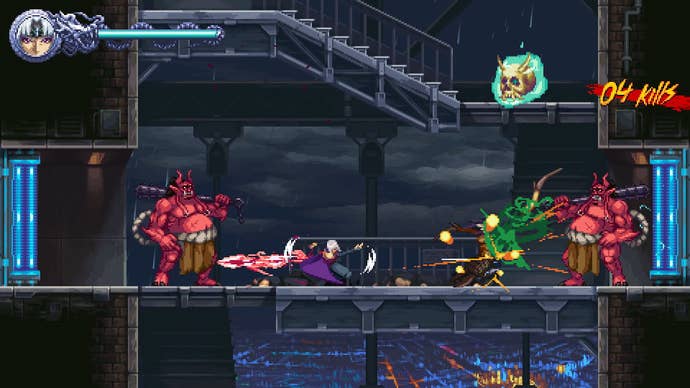Ninja Gaiden: Ragebound will set your village on fire, as is only proper
We've played a bit
How many times has Hayabusa village burned down? Some Ninja Gaiden freaks out there must know. This aged series has changed a lot in the decades since its NES debut, but that blazing home village has become a running gag. Ninja Gaiden games are slicey-dicey outings of varying quality in which Ryu Hayabusa must kill everything he dislikes yet again. But in the upcoming Ninja Gaiden: Ragebound, it's going back to 2D, largely without Ryu. I scuttled along to a demo session to play the "neo-retro" action platformer, and found that the familiar hero does show up as a tutorial mentor you can battle. You might, unlike me, even be able to defeat him. But it won't matter. Your village will be burnt to the ground anyway.
"Because what would be a Ninja Gaiden game without it?" jokes game director David Jaumandreu of The Game Kitchen, who've been hired by Team Ninja to render those flames in old-school pixel art.
The Game Kitchen are best known for Blasphemous and its sequel, the most metalheaded of metroidvanias. I won't pretend to be a diehard fan of Ninja Gaiden games, but at least this Spanish studio seems to have enough love for them to recognise a few absolute necessities (village on fire, for instance). There is a gore filter in the options you can turn on or off, which I pre-emptively mention specifically for Ninja Gaiden Sigma 2 dislikers (everyone else, don't ask). But other essential ingredients of old-school Gaiden took longer to recognise.
Here you'll be playing as apprentice Kenji and daggerlady Kumori - an odd couple forced to work together to fight demons. When Ragebound was still a prototype, we're told, the combat was more akin to its modern 3D counterparts. There were "spongey" enemies that would need multiple hits, and you'd perform combos to biff them into bloodpulp. The Game Kitchen were making what might pass for a hacky slashy 2D action demake of moderno-Gaiden.
"But when trying that in the game," says Jaumandreu, "it kind of didn't feel good. Combo heavy combat, it's quite good in open spaces in 3D. But it's kind of harder to [reproduce] in 2D."
They "quite quickly" realised that what made 8-bit and 16-bit Ninja Gaiden feel good: a sense of "pushing and moving forward", and dispatching bad guys in a single efficient swat.

If you have to hit a bad guy twice, you've already screwed up. This is the philosophy of Ragebound, which takes the sword swinging of a 36-year-old series back to its roots as a swipey, side-scrolling ninja 'em up. As in the Nintendo games of yore, you'll kill most enemies in a single slash or knife toss, as you sprint across arcadey stages of forest floor or fishing pier. The developers call it a "one-hit predominant" game. Of course, they've included some basic enemies that might take two, three, or four hits to kill. But if things come to that, it is heavily implied you are playing as a sub-optimal rube.
Ragebound's trick is not flashy, but it is effective. Every so often a "blocker" enemy will appear as you dash through its levels. Charging them head-on will see you slashing at the big guys repeatedly. But check around for a glowing blue or pink enemy and whack those dweebs with the corresponding attack (a slash for blue dirtbags, a throwing knife for pink scum) and you'll be briefly charged with the energy required to kill a "blocker" dude with a single hit. The inference is clear from the moment you put all this together: there will be a "perfect" way to play this tough and twitchy game. Friends, I have not managed it.
Alongside the one-hit winishers comes the traditional wall-clambering and ceiling clutching of the classics. Then it's all slapped it together with some modern "tools" to deal with the fending off of fiends. There's your invincible dodgeroll to get through enemies, your frequent checkpoints, your screen-clearing super attack. If you've leapt into the air, you can press jump again when you touch an enemy (or the ninja star they've just lobbed) to bounce off that, effectively double jumping on baddie heads. The same trick lets you use angry fish or projectiles as stepping stones to close a gap.
It wasn't shown in the build I played but you'll also get a taste of some weaponry, along with the ability to buy upgrades from a shopkeeper along the way. Ye olde Ninja Gaiden had fireballs and ghostly followers, so it's possible we might see some riffs on old gear like that.

On top of these skills, there is a purplish killer who hangs behind you as you slash and/or dash. Kumori is your secondary hero, a white-haired ghost gal with a pair of kunai. As a Black Spider clan member, I'm told she'd ordinarily be a deadly adversary to the Ryus and Kenjis of the world. But something has happened that leaves her bound in spirit form, attached to Kenji as a sometimes helpful, sometimes snarky companion. A shoulder phantom throwing literal shade.
Her throwing knives and "spider weapon" attacks turn combat into that truly twitchy game of blopping the right dork with the correctly coloured attack - blue or pink - an unfolding of sequential batterings that I suspect will make speedrunner heads turn ever so slightly Gaidenward. It's pretty basic in form, but on every enemy-filled screen it felt like there was an intelligent and correct order in which to kill the lot. Even if, in the moment, my reflexes didn't catch it in time.
In some levels you'll have to strap Kenji to freaky altars. This will see you take lone control of the spectral Kumori in a mildly altered spirit realm. Turns out ghosts just spend all day precision platforming while outrunning a cooldown timer by smashing orbs. It's a brief dip into (again) speedrunny gauntlets. But they don't seem to overly punish you for failure, just zapping you back to the start of her trial if the time runs out. Kumori's sequences usually open the way for her reluctant ninja pal Kenji by unlocking some passage, or they might simply let you grab a collectible or hidden golden money-beetle to be used at the shopkeeper.

But what is any of this for? What do Kenji and his pals want? To stop the "Demon Lord", whoever that is. Speaking as a stranger to the series (a Ninja Gaijin?) I get the feeling that story and character are very much an afterthought. From what I've seen, it doesn't go beyond the simplistic hero's quest. You literally have to find three crystals scattered across the land. I know this is a homage to an era when all games were about finding bits of old geode somebody dropped 5000 miles away, but considering so much effort has gone into modernising the moment-to-moment handling of your ninja, it's mildly disappointing the plot still revolves around what passes for a story in 1980s arcade games. But maybe there's some fun friction to be explored in the hero and his haunting hellfriend. Perhaps a more interesting tale will become clear.
But not until some time later this year, says publisher Dotemu. For all their pixel art precision in Blasphemous and its sequel, The Game Kitchen haven't worked on another company's baby before. Now they find themselves childminding a beloved assassin belonging to Team Ninja. I'm told the Japanese parents sometimes play the builds and call up the developers to say (and I'm paraphrasing here) "hey, that enemy who's really hard to kill is cool, put loads of that in".
The Game Kitchen aren't putting aside their own projects as a result of such collaborations, they say, but they do find this work-for-hire approach "comfortable", according to director Jaumandreu. I don't know exactly what the neo-retro offloading of franchises means for fans of Ninja Gaiden's [checks notes] "Izuna Drop", but I can tell you that after a simple hour of leapin' and loppin' my hands found Ragebound fairly flow-inducing, if a little straightforward. I'll wait and see if the devs can knock it out in a single thwack.


